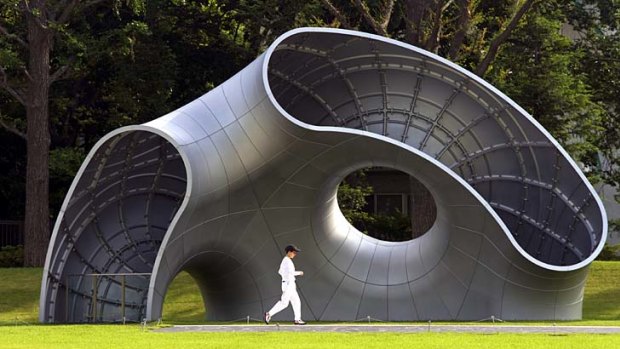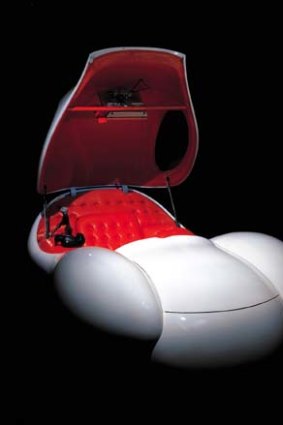This was published 12 years ago
Shock of the new
Raymond Gill finds the energy of Tokyo's street life is the ideal backdrop to a tour of its contemporary art.

Art outdoors at Midtown Garden, Roppongi.Credit: AFP
Travellers to cities whose names feature on perfume bottles - London, Paris, New York - routinely spend time in major public galleries.
Between visiting landmarks, eating at well-known cafes and restaurants and shopping at famous department stores, first-time visitors and well-travelled art lovers pay homage to "destination" paintings, revisit favourite works and chance upon blockbusters. The itinerary is usually along these lines: London's Tate Modern, National Portrait Gallery, National Gallery and Royal Academy; Paris's Louvre, Musee d'Orsay, Pompidou Centre and the Picasso Museum; and New York's Metropolitan, Guggenheim, Frick and the Museum of Modern Art.
Tokyo's public galleries are no less sensational or numerous, yet they tend to feature less prominently on tourist trails. Perhaps it's because the quotidian wonders of Tokyo get in the way. There are the crowds milling so fast they make New York's Times Square look like Albury-Wodonga on a Monday night. There are the neon-festooned skyscrapers crowned by blinking red lights and wrapped by freeways, like a scene from Metropolis. There is the glorious everyday food, from bento boxes in department-store food halls to beers at izakayas (bar meets cafe meets family kitchen).
There is the incongruity of old and new, when you spot a woman in a traditional kimono lining up to buy Diet Coke at a konbini (convenience store). And there's the odd duality of Japanese culture: in this toy shop, should I buy the cutesy Hello Kitty gear or go for the Kill! Kill! Kill! thrills of an evil plastic Godzilla?
This is my third visit to Tokyo but the first time I've had the chance to explore the city's art scene. Where to begin?
It's fortunate in more ways than one that I'm staying at the Peninsula Tokyo hotel in buzzy Ginza, which is sometimes cited as the city's answer to New York's Madison Avenue. It considers itself an "art hotel". This term can sometimes mean a two-star joint in a back street with bad Salvador Dali-esque murals painted over its cracks. But this five-star showcase of a hotel contains 1000 works - some of which are in public areas - by 60 artists, most of them Japanese.

Material world ... Lee Bul's fibreglass capsule at the Mori Art Museum.
The foyer is dominated by designer Keisen Hama's sinuous bamboo sculpture Lying Dragon Gate, depicting a supine dragon, but in the most abstract Japanese way. On each of the hotel's 24 floors you can stand at the lift doors and look down into a glass vitrine where sperm-like mesh sculptures appear to float in inky darkness above and below. No wonder the work is titled The Void.
All of the Peninsula's guest rooms contain delicately designed art and objects in clay, paper, glass or unadorned metals whose sinuous shapes complement the "ajiro" ceiling panels of cedar. The hotel's fifth-floor spa, with its half-moon swimming pool, has views of the endless traffic looping around the Imperial Gardens. It might not be artistic but it's certainly cinematic.
After letting the hotel concierge know I'm interested in seeing nearby galleries, I'm given the hotel's mini-guide, This Way Tokyo, which lists 11 boutique galleries in the neighbourhood.
Should I start at the Hara Museum of Modern Art, located in a 1938 Bauhaus-inspired residence, or SCAI the Bathhouse, with contemporary art displayed in an old onsen? Or perhaps head to Nihon Mingeikan, for "utilitarian works of beauty made by anonymous craftspeople"?
I decide an expert's overview is needed, so I head to the Art Front Gallery in Shibuya, a 20-minute cab ride. This small gallery space is housed in one of the few remaining examples of "metabolist" buildings in the city, named for the 1960s "organic" Japanese architectural movement, surveyed recently in a blockbuster show in one of Tokyo's biggest galleries, the Mori Art Museum.
The Art Front Gallery stages regular exhibitions by Japanese artists, its 40 staff produce art magazines and journals and its senior staff oversee one of the world's largest art events: the Echigo-Tsumari triennial of contemporary art, held in rural Niigata, two hours by train west of Tokyo. Art Front also organises all the art for the Peninsula Tokyo.
When I visit, Art Front's offices are filled with models sent by Australian architects for a competition to design the triennial's "Australia House", which was levelled by last year's earthquake. (This year's triennial, opening for three months from July 29, will have Melbourne artist Brook Andrew in residence.)
Art Front's manager, Toshio Kondo, is a quiet and sober man who quickly scotches my preconceptions of Tokyo's contemporary art being as dynamic as New York's or Berlin's. No, he respectfully advises, there are only about 500 serious collectors of contemporary art in the country. There are no branches of successful American or European private galleries in Tokyo and little government support for artists exploring new forms. And no, the market for and interest in video art has declined in the past decade, when comics and anime were the buzzwords.
He says international interest in new Japanese art has been overshadowed by the thriving Chinese contemporary art market and, at home, the Japanese are highly educated to appreciate traditional art forms but have little interest in the new. On the bright side, however, Japanese artists continue to produce beautiful, delicate abstract art. "Japanese art is about showing the material and how it changes its surface," Kondo says.
I leave slightly deflated but with a list of must-see galleries that should provide an overview of the state of Tokyo's arts. I soon discover that the depth and breadth of the art on display would take 10 days to explore. Its range embraces the traditional and the avant-garde and puts the efforts of Australian public galleries in the shade.
There are plenty of Western blockbusters on show - the Japanese particularly love the French impressionists. The National Museum of Western Art has a core "Matsukata Collection" of French impressionists and Auguste Rodin sculptures. From March 6 until May 20 it is showing works by French landscape painter Hubert Robert (1733-1808) in an exhibition entitled Les Jardins du Temps.
The Tokyo National Museum is where you go to see traditional Japanese art forms, including calligraphy and archaeological finds. From March 20 until June 10 it is showing Japanese Masterpieces from the Museum of Fine Arts, Boston. But perhaps more interesting - and, in my view, a must-see - is the entertaining and informative National Museum of Modern Art, which focuses on Japanese art from the 19th century. Its collection of Japanese and Western art tells the story of how Japanese artists have been influenced by Western art since about 1907. The gallery, a few hundred metres from the Peninsula hotel, is showing Jackson Pollock: A Centennial Retrospective until May 6, with many of the works from its own collection and from MoMA in New York. Also until May 6 it is showing 150 works by modernist Japanese poster designer Hara Hiromu (1903-86), whose images graced posters, tickets and catalogue covers for exhibitions at the National Museum of Modern Art, Tokyo, from 1952 until 1972.
For the shock of the new, see the strikingly modern Museum of Contemporary Art, Tokyo. A visit to the museum in Kiba Park, to the east of central Tokyo and a 30-minute subway ride away, is worthwhile for the sheer size and scope of this new gallery dedicated to the most adventurous contemporary art from Japan and around the world. It makes similar galleries in Sydney and Melbourne look small town.
It is showing work by Japanese painter Ay-O until May 6 and work by the installation and performance artist Atsuko Tanaka (1932-2005), whose work with fluorescent lights and bulbs gives the American artist Dan Flavin a run for his money.
To combine art, shopping and eating, head to the more central Art Triangle in the Roppongi district (the city's big galleries aren't particularly savvy when it comes to snacks and meals). In this hilly district is the five-year-old National Art Centre, with a glass-mesh exterior. Until April 2 it is celebrating the work of Japanese painter Noda Hiroji with 140 of his works from 1981 to 2011, showing his abstract paintings on folded, sewn and layered canvas.
Also in the "triangle" is the Suntory Museum of Art, with an emphasis on Japanese arts and crafts, and the sensational Mori Art Museum, dedicated to contemporary art and owned by the real estate tycoon Minoru Mori. His gallery sits on the top two floors of his 54-storey tower and has sensational city views best seen from a sky deck, accessed through a separate (paid) entrance.
The Mori Art Museum's recent "metabolist" show of architectural models on its two enormous floors was a knockout. It is now showing Lee Bul: From Me, Belongs to You Only until May 27. Billed as "Asia's leading female artist", Lee Bul's wild and strange sculptures and "pods" are glittering, beautiful and a little scary.
In a different vein, the Museum of the Imperial Collections is Japan's oldest and largest museum and the Tokyo National Museum contains ancient Japanese arts and archaeological exhibits.
And then there's Tokyo's small private art galleries, concentrated in Ginza and CET (central east Tokyo), and even more art for public viewing in the department stores clustered in the retail areas of Ginza, Shibuya and Shinjuku. These stores usually have their own art and craft galleries on their top floors, ranging from exquisitely crafted bowls and glassware to - you guessed it - French impressionist-style paintings.
Raymond Gill travelled courtesy of the Japan Foundation and the Peninsula Tokyo.
FAST FACT
Getting there
Malaysia Airlines flies to Tokyo from Sydney for about $1310 return. Fly to Kuala Lumpur (about 8hr), then to Tokyo (6hr 40min); see malaysiaairlines.com.
Art viewing
The National Museum of Western Art is open daily 9.30am-5.30pm, until 8pm on Friday and closed on Monday. Entry ¥420 ($4.90). Closest subway: Ueno. See www.nmwa.go.jp.
Tokyo National Museum is open daily 9.30am-5pm, until 8pm Friday and until 6pm Saturday and Sunday. Entry ¥600. Closest subway: Ueno. See www.tnm.jp.
National Museum of Modern Art is open daily 10am-5pm, until 8pm Friday and is closed Monday. Entry ¥420. Closest subway: Takebashi. See www.momat.go.jp.
The Museum of Contemporary Art Tokyo is open daily 10am-6pm and closed Monday. Entry ¥500. Closest subway: Kikukawa. See mot-art-museum.jp.
National Art Centre is open daily 10am-6pm, until 8pm Friday and closed Tuesday. Entry from ¥1000. Closest subways: Roppongi or Nogizaka.
See www.nact.jp.
Suntory Museum of Art is open daily 10am-6pm, until 8pm Friday and Saturday, and closed Tuesday.
Entry fees vary. Closest subway: Roppongi. See www.suntory.com/culture-sports/sma.
Mori Art Museum is open daily
10am-10pm and 10am-5pm Tuesday. Entry fees vary. Closest subway: Roppongi. See mori.art.museum.
Staying there
The Peninsula Tokyo has double rooms from ¥52,175; see peninsula.com/Tokyo.
Sign up for the Traveller Deals newsletter
Get exclusive travel deals delivered straight to your inbox. Sign up now.